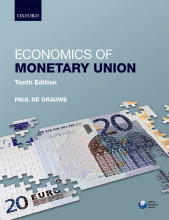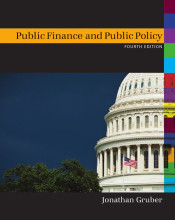Summary: Economics Of Monetary Union | 9780199684441 | Paul De Grauwe
- This + 400k other summaries
- A unique study and practice tool
- Never study anything twice again
- Get the grades you hope for
- 100% sure, 100% understanding
Read the summary and the most important questions on Economics of Monetary Union | 9780199684441 | Paul De Grauwe
-
1 The costs of a common currency
This is a preview. There are 1 more flashcards available for chapter 1
Show more cards here -
What mechanisms lead to automatic equilibration after a shift in demand?
Wage flexibility and mobility of labour -
What is the most important cost to a country when entering a MU?
It relinquishes its national currency: cannot conduct a national monetary policy, i.e. cannot determine quantity of national money in circulation or change short-term interest rate -
Why is the theory of Mundell (1961) incomplete, stating when in a MU, a country loses monetary independence, affecting the capacity to deal with asymmetric shocks?
It overlooks another major implication of loss of monetary independence, namely that a MU changes the capacity of governments to finance their budget deficits: this was overlooked until the sovereign debt crisis in the Eurozone emerged in 2010 -
How can a liquidity crisis set a solvency problem in motion?
The government debt burden increases, forcing governmentto reduce spending and increase taxation. This may lead to a government to stop servicing debt and to declare a default. -
Name two effects of a negative demand shock on the French government budget
1. Decline of French GDP (leads to decline of government tax receipts)
2. Unemployment increases, French government expenditure increases; budget deficit increases -
How does a debt crisis in France lead to amplification of asymmetric demand shocks?
Investors sell French government bonds, get euros, want to buy other bonds. Investors buy German government bonds, price of these will increase, yield will decrease. The interest rate in Germany declines, increasing demand in Germany. Hence, positive demand shock is reinforced by an additional shift in demand curve: adjustment problem intensified.
In MU: interest rates can diverge while they are long-term (rates on government bonds). Diverge if investors attach different risks of holding different bonds: French bonds riskier, want a higher interest rate (yield). Short term interest rates are the same everywhere, under control of the common central bank. -
How can the costs (asymmetric demand shocks leading to increasing budgget deficits) of a MU be reduced?
1. the central bank might make it possible to avoid liquidity crisis
2. centralizing a significant part of the national budgets into a common union budget
> creates an insurance mechanism distributing income transfers from country experiencing good times to bad ones: EU government levies taxes in booming Germany, higher G spending in France (unemployment benefits).
! leads to moral hazard. Trasnfers tend to reduce the pressure on regions to adjust. -
What is an incomplete monetary union?
A monetary union without budgetary union -
Explain, using the theory of Bruno and Sachs (1985) concerning the importance of labour market institutions, the difference between centralized and decentralized wage bargainging
After a supply shock (e.g. increase in oil price):
centralized
labour unions take into account that excessive wage claims lead to more inflation, which leaves real wages similar. Thus, they will not make excessive wage claims.
decentralized
individual unions that bargain for higher norminal wages, know that the effect of these wage increases on price level (inflation) is small, since they only represent a small fraction. Free riding problem! If the union does not increase nominal wage, real wages of its members decline, since other unions to increase nominal wage. Result: Higher wage claims. -
2 The theory of optimum currency areas: a critique
This is a preview. There are 6 more flashcards available for chapter 2
Show more cards here -
What are 'wet' and 'hard-nosed' governments?
wet
Authorities who care a good deal about unemployment, i.e. have steep indifference curves: in order to reduce the rate of unemployment by one percentage point, they are willing to accept a lot of additional inflation.
hard-nosed
authorities willing to let theunemployment rate increase a lot in order to reduce the infaltion rate by one percentage point
- Higher grades + faster learning
- Never study anything twice
- 100% sure, 100% understanding































